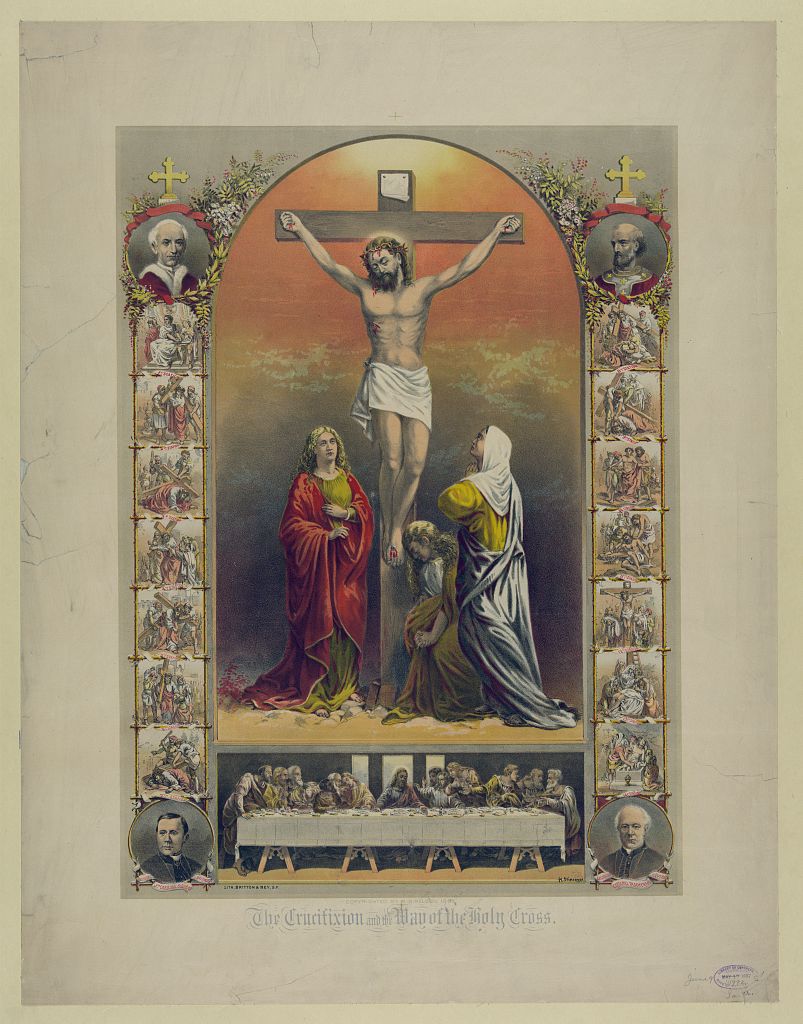Above: The Crucifixion and the Way of the Holy Cross, June 9, 1887
Image Source = Library of Congress
Reproduction Number = LC-DIG-pga-00312
The Exaltation of the Holy Cross
++++++++++++++++++++++++++++++++++++++++++++++++++++++
The Feast of the Holy Cross commemorates two events–The discovery of the supposed true cross by St. Helena on September 14, 320, and the dedication of the Church of the Holy Sepulchre, Jerusalem, on that day in 335, on the anniversary of the dedication of the First Temple in Jerusalem. In the Eastern Orthodox Church the corresponding commemoration is the Exaltation of the Holy Cross.
The Feast of the Holy Cross has had an interesting history. It existed in Constantinople in the 600s and in Rome in the 800s. The feast did not transfer into Anglicanism initially. It did become a lesser feast–a black-letter day–in The Book of Common Prayer in 1561. In The Church of England The Alternative Service Book (1980) kept Holy Cross Day as a black-letter day, but Common Worship (2000) promoted the commemoration to a major feast–a red-letter day. The Episcopal Church dropped Holy Cross Day in 1789 but added it–as a red-letter day–during Prayer Book revision in the 1970s. The feast remained outside the mainstream of U.S. and Canadian Lutheranism until the Lutheran Book of Worship (1978) and its variant, Lutheran Worship (1982).
Without getting lost in the narrative weeds (especially in Numbers 21), one needs to know that God chastises Jews and Christians for their sins yet does not destroy them, except when He allegedly sends poisonous snakes to attack them. Then God provides a healing mechanism. We should look up toward God, not grumble in a lack of gratitude. Isaiah 45:21-25, set toward the end of the Babylonian Exile, argues that God is the master of history, and that the vindication of the former Kingdom of Judah will benefit Gentiles also, for Gentiles will receive invitations to worship the one true God. Many will accept, we read. In the Gospel of John the exaltation of Jesus is his crucifixion. That is counter-intuitive; it might even be shocking. If so, recall 1 Corinthians 1:23–Christ crucified is a stumbling block to Jews and foolishness to Gentiles. God frequently works in ways we do not understand. John 12 mentions some God-fearers, Gentiles who worshiped YHWH. This reference picks up from Isaiah 45:21-25. It also fits well with the Pauline mission to Gentiles and emphasis on Christ crucified.
As for God sending poisonous snakes to bite grumbling Israelites, that does not fit into my concept of God. My God-concept encompasses both judgment and mercy, but not that kind of behavior.
The choice of the cross as the symbol of Christianity is wonderfully ironic. The cross, an instrument of judicial murder and the creation of fear meant to inspire cowering submission to Roman authority, has become a symbol of divine love, sacrifice, and victory. A symbol means what people agree it means; that is what makes it a symbol. Long after the demise of the Roman Empire, the cross remains a transformed symbol.
The Episcopal collect for Holy Cross Day invites us to take up a cross and follow Jesus. In Cotton Patch Gospel (1982), the play based on Clarence Jordan‘s The Cotton Patch Version of Matthew and John, Jesus, says that a person not willing to accept his or her lynching is unworthy of Him.
That is indeed a high standard.
KENNETH RANDOLPH TAYLOR
AUGUST 1, 2018 COMMON ERA
THE FEAST OF SAINT JOSEPH OF ARIMATHEA, DISCIPLE OF JESUS
++++++++++++++++++++++++++++++++++++++++++++++++++++++
Almighty God, whose Son our Savior Jesus Christ was lifted high upon the cross
that he might draw the whole world to himself:
Mercifully grant that we, who glory in the mystery of our redemption,
may take up our cross and follow him;
who lives and reigns with you and the Holy Spirit, one God, in glory everlasting. Amen.
Isaiah 45:21-25
Psalm 98 or 8:1-4
Philippians 2:5-11 or Galatians 6:14-18
John 12:31-36a
—Holy Women, Holy Men: Celebrating the Saints (2010), 581
++++++++++++++++++
Almighty God, your Son Jesus Christ was lifted high upon the cross
that he might draw the whole world to himself.
To those who look upon the cross, grant your wisdom, healing, and eternal life,
through Jesus Christ, our Savior and Lord, who lives and reigns with
you and the Holy Spirit, one God, now and forever. Amen.
Numbers 21:4b-9
Psalm 98:1-4 or 78:1-2, 34-38
1 Corinthians 1:18-24
John 3:13-17
—Evangelical Lutheran Worship (2006), 57
++++++++++++++++++
Numbers 21:4-9
1 Corinthians 1:18-25
John 12:20-33
—Lutheran Service Book (2006), xxiii
++++++++++++++++++++++++++++++++++++++++++++++++++++++
Originally published at SUNDRY THOUGHTS
++++++++++++++++++++++++++++++++++++++++++++++++++++++


You must be logged in to post a comment.